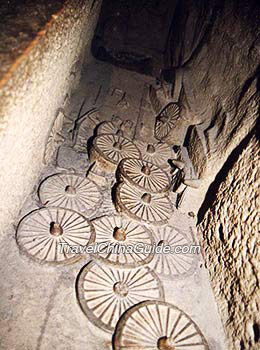Western Zhou Chariot Burial Pit
Situated in Mawang Town, Chang'an District in Xi'an City, the Western Zhou Chariot Burial Pit Group is a part of the ancient Fenghao Site. The site is the historical ruins of Fengjing and Haojing, which are the capital cities of the Western Zhou Dynasty (11th century BC - 771 BC). The huge Fenghao Site covers six square miles (about 17 square kilometers) in total, stretching across both Mawang and Doumen towns on the two banks of Fenghe River. The burial pits group, lying on the west bank, is commonly known as Fengxi Chariot Burial Pit. ‘Fengxi’ literally means the west of Fenghe River.
Although not as famous as the burial pits of the Terracotta Army of the Qin Dynasty (221 - 207 BC) and the burial pits of Yangling Mausoleum of Han Dynasty (202 BC - 220 AD), Western Zhou Chariot Burial Pit had also made a great sensation in 1956 when it was first unearthed. The reason being it is deemed to be older than the Terracotta Army by about 600 years. What’s more, instead of pottery figurines, there were real horses and human beings buried in the pits! Although it may sound brutal, the Western Zhou Chariot Burial Pit represents the sacrificial tomb of China’s slavery society in olden times. As much, the Western Zhou Chariot Burial Pit Museum becomes a center to learn about imperial funeral culture of ancient China.
The system of burying the living with the dead can date back to the Shang Dynasty (16th - 11th century BC). Many slaves were killed or forced to commit suicide, and then buried together with their owners. The slave society peaked during the Western Zhou Dynasty. During that period, horses and carters were buried alive together with their dead master. It was believed then that tombs were their residences after death and hence they still needed to live a comfortable and luxurious life in the spiritual world. The West Zhou Chariot Burial Pit Museum covers an area of 4.6 acres (1.86 hectares), and the exhibition area covers 3,600 square yards (3,000 square meters). Upon entering, one can see the grand main building covered with a red four-corner pavilion roof. Within the building, there are the exhibition hall, two groups of tombs, and seven chariot pits, of which four are excavated.
The West Zhou Chariot Burial Pit Museum covers an area of 4.6 acres (1.86 hectares), and the exhibition area covers 3,600 square yards (3,000 square meters). Upon entering, one can see the grand main building covered with a red four-corner pavilion roof. Within the building, there are the exhibition hall, two groups of tombs, and seven chariot pits, of which four are excavated.
The no. 1 pit is subquadrate with a length of 10.8 feet (3.3 m), and there are a chariot, two horses, and a slave buried alive with his deceased master.
The no. 2 pit is the only pit open to the public. Pit no. 2 holds two chariots, six horses, and a slave. The rectangular pit measures 18 feet (5.6 m) long and 6.6 feet (2 m) deep. Two wooden chariots measuring 2 feet (0.68 m) in length by 4.5 feet (1.38 m) in width and standing over 1.5 feet tall (0.45 m) are arranged side by side in the pit with their thills facing east. Doors measuring about 1.3 feet (0.4 m) in width are located at the rear of the chariots. Railings made of small battens stand beside each door. One chariot decorated in bronze was used in battle and hauled by four horses. The other chariot hauled by two horses and adorned in seashells was used mainly for transport. Six dead horses crouch directly opposite the chariots. They were obviously killed prior to the burial and arranged in this position. The heads of the horses are covered with silver beast-face ornaments. Under one chariot lies a skeleton, believed to be the wagoner of the tomb owner. From the number of horses, slaves and ornaments discovered, it’s easy to tell that the owner of the tomb was fairly well off.
The no. 3 pit lies at 65 feet (about 20 m) north of the no. 2 pit, housing a chariot hauled by two horses and a slave. Around 32 feet (10 m) northwest to the no. 1 pit is the no. 4 pit, the largest one that measures 30 feet (9 m) long and 13 feet (4 m) wide. There are three chariots, eight horses and a slave.
Excavated chariots and horses confirm that the metal industry, woodworking and leather production were highly developed during this prosperous period. Valuable and artistic relics made of pottery, jade, bronze, and stone fully reflect the ingenuity and wisdom of the ancient Chinese people. Here you can find relics such as the bronze vessel with the inscription of 43 Chinese characters, spicule, bone arrow, zax, spear, and bronze broadsword.
How to get the Western Zhou Chariot Burial Pit
Xi'an Bus / Metro Search
| Admission Fee | CNY 10 |
| Opening Hours | 8:00 - 17:00 |